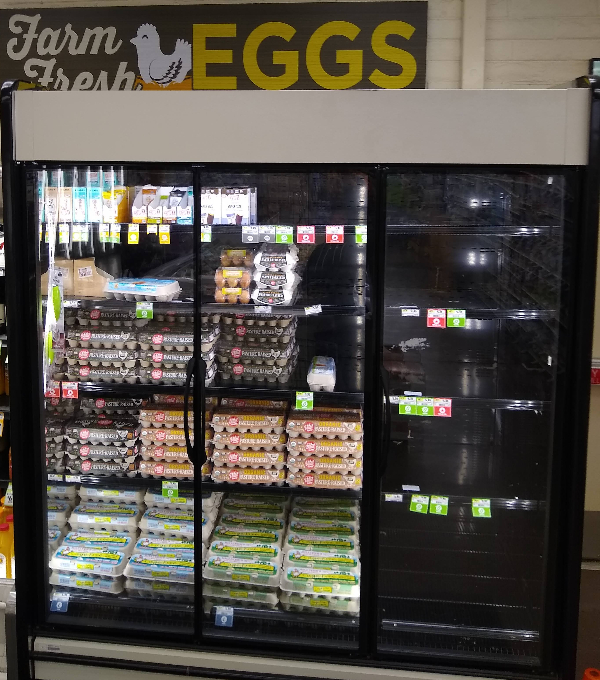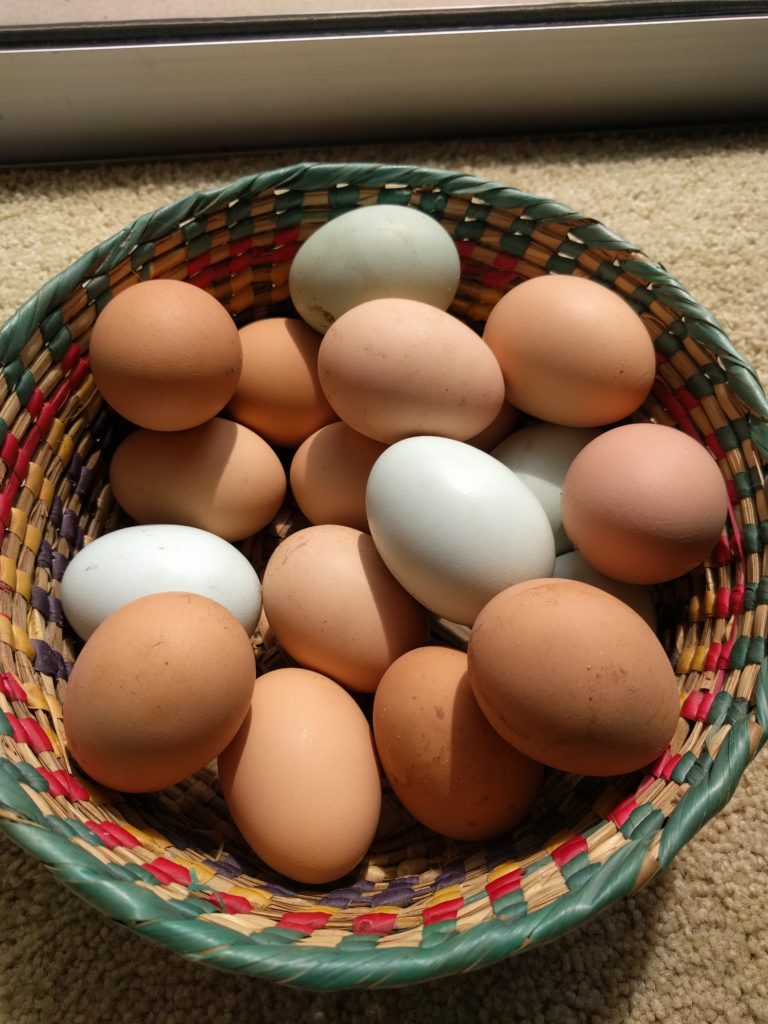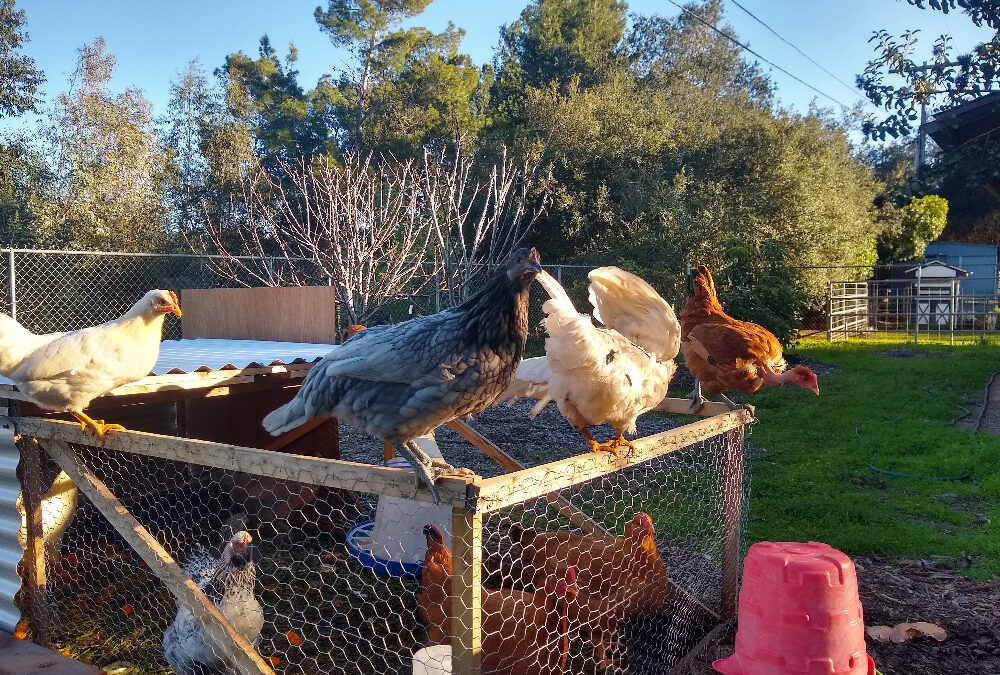My son might have the power to see the future. Last year, he kept begging me to let him raise some chicks so he could sell their eggs. Had I immediately helped him along in this venture, he would now be making customers very happy and healthy.
Alas, I could not foresee that 2023 would be a year of empty shelves in the egg coolers at grocery stores.

So I was in no rush. I tried to be a responsible father by first making my son care for the hens we already had. If he did that on his own for a couple weeks, then I would let him buy chicks.
Miles did the couple weeks’ of chicken chores so we bought 18 chicks that arrived at the post office on October 14, 2022. Here in February, these birds are now a few weeks away from laying their first eggs.
Lately, we have been going through some numbers: How much does it cost to feed them? How much did we spend building their coop? How much should he charge for their eggs?
I thought I’d parlay that discussion into a post that might help you get a sense of what the costs and benefits would be of keeping chickens in your yard. Just remember that these are rough numbers that pertain to our conditions. I’m just laying them down in order to gain an overall impression of the economics.
Costs
The 18 chicks cost $72 from Murray McMurray Hatchery. That’s $4 per chick.

For their early days, we bought a tub to use as a brooder, and a lamp and pine shavings and grit. We already had a waterer and feeder. All together, those cost about $110.
I built a simple shelter that cost about $200 in materials. (To build the same shelter cost me only $100 in materials back in 2016!)
We’ll get a lot of future use out of the equipment and shelter so I’m going to knock 50% off of the $310 total for those. Let’s call it $150. Split among the 18 chicks makes it about $8 per bird.
The cost of feeding the chicks ramps up as they get older and eat more. We feed them kitchen scraps and garden scraps, and I also let them roam to forage on weeds and worms and bugs here and there. We supplement with purchased feed.
I estimate that the cost of feeding from day one to laying age (about six months old) is $15, per bird. Now that they are full size, they are going through purchased feed at the rate of about $0.77 per bird per week. That is a feed cost of about $40 per mature bird per year.
Benefits
Once the hens start laying, you reap the rewards of eggs. Most egg-laying breeds produce four or five eggs per week for their first two years of laying, or about 200-250 eggs per year, including time off while they’re molting and during the less productive season of winter.
How much are eggs worth? Yesterday, I found a carton of organic pastured eggs at our local grocery store selling for $0.64 per egg ($11.50 for 18).
I mentioned this to Miles and he replied, “Our chickens are healthier so their eggs are healthier. I’m thinking of charging ten cents more.”

Costs and benefits weighed
But let’s say he just charges $0.64 per egg. What then is the rough balance between what our chickens cost compared to their egg value?
Over the course of 2.5 years, the cost of the chicken is $95 and the earnings from eggs is $256. That is $161 in the black.
Costs: At $8 per bird for brooder equipment and shelter plus $15 for feed up until laying age (about six months old), we have $23. From there it is $40 in feed per year. So for the first 2.5 years of a single chicken’s life, the cost is $95.
Egg earnings: If a hen makes 200 eggs per year, and each egg is valued at $0.64, then it earns $128 per year or $256 over two years.

Not everything is included in this equation. But will approximately $161 in profit from the eggs of one hen per year be worth a seven-year old’s time? I’m guessing it will. I’ll keep you posted.
Would chickens be worth your time? How about if, in addition to the eggs, the chickens provided other valuable services in your yard, such as making compost and performing pest control?
A couple other chicken posts:
“Why a chicken coop and run should have a floor of wood chips”
All of my Yard Posts are listed HERE
I make these Yard Posts for you, and I appreciate your support.




To anyone thinking about getting hens, I recommend the amberlink and red sex link breeds for consistent laying of brown eggs. Being small framed, they don’t eat a ton. And my 4 are on track to lay over 300 per hen per year (but they are only 10 months old right now), without a hint of slowing down over the winter.
Can you recommend any reputable places to get amberlink and red sex link breeds? I’m in So California.
Hi Linda,
I see that Murray McMurray Hatchery carries these two, and we have had very good experiences ordering from them. Here is their Amberlink page: https://www.mcmurrayhatchery.com/amberlink.html
Thank you.
Thanks for this, El Matavenados. We have our first Amberlink (Amber Star) right now; looking forward to seeing how she does.
We’ve never had a Red Sex Link. It looks like that breed (not a true breed, but a cross) also goes by a couple of other names: Red Star and ISA Brown. And the descriptions sound amazing.
Can I ask what kind of feed you use? The cost of feed has almost doubled in the past several years. We were using organic Scratch & Peck Layer but with older hens slowing their laying it’s not at all economical.
Hi Ann,
I don’t know if this will work for you, but I have my chickens on a deep bed of wood chips now and this has greatly reduced their need for feed. See my post: https://gregalder.com/yardposts/why-a-chicken-coop-and-run-should-have-a-floor-of-wood-chips/
Watch out for predators. It would be so discouraging, especially for your son, to find them all killed one morning if something gets into the coop.
Livestock guardian dogs are used by many pastured poultry farmers. Or electric net fence from Premier one fence online.
Speaking as someone whose family has lost hundreds of sheep to loose dogs, coyotes, and other predators.
Bobcats are a big problem with chickens in our area, Sonoma County.
Not to be naive, but what todo you do after they stop laying in a couple years. They live much longer? Do you factor the cost of keeping the hen with no production?
Up here in Sonoma County I sell my eggs for $7 and sell my three year old hens to the local feed store for about six bucks which I use to recapitalize new hens. I like to keep blue and green egg layers as well as brown layers ‘cause it makes for a nicer presentation in the cartons
That sounds like an efficient arrangement, Bob. My son also chose a mix of breeds to be able to make cartons of different colored eggs. For blue eggs, we are trying a new breed (new to us) called Whiting True Blue, and so far we really like those birds.
Yes, I’ve seen those at the McMurray website and may have a few coming this summer along with a few others. I normally use my own fertile eggs and let the ladies do the hatching for me but would like some outside blood this year. I will be timing a hatch for when they get here so I won’t have to use heat and lights and will foster them in with the others. It makes for a really busy mom! I found your website while looking for cold hardy avocado trees and am thankful for your work.
Bob
Hi Bob – I’m in Sonoma County and buy eggs from a rescue farm at $10 carton ($12 for duck eggs) they are amazing. But I also buy eggs weekly through FEEDSonoma CSA from their farm partners and those run about $10-$11 each. We are only 2 people and eat eggs on weekends mostly but bake with them and I rather pay more for quality pastured eggs. I haven’t bought eggs at the grocery store in ages. I think you could charge more. I LOVE the blue and green ones and speckled as well. With 2 dogs we’re not likely to take on chickens so we support local as much as possible.
Hi Mariangela, yes I’ve been considering raising the price for our pasture raised eggs. The price of organic feed has really gone up in the last year. So when they come out of their winter slumber I will. We only have 30 hens on our five acres so they have plenty to eat.🐓🥚
Great questions, Brandon. There are a few options and no right answer for everyone. Farmers never keep laying hens beyond a couple years because their profitability goes down. They sell the birds as stewing hens, for cat food, etc. They have to treat the chickens as production units.
The hens will live much longer than two years though. Around five years is probably average, but one of our neighbor’s hens lived to 11!
When I got our first chickens I intended to slaughter the hens for eating after a few years, but then the kids named them all and they became more like pets and I scrapped that idea. We just keep our chickens for as long as they live. They do continue to produce eggs albeit fewer, and they eat less as they get older too, which makes it slightly less expensive to feed them.
In some ways, I really appreciate our older hens because they are trained to my routines and they are easier to manage.
I think they end up on the barbecue when they stop laying eggs.
Oh, Sharon. You are so right. We’ve already encountered some of that.
Even sadder than losing a chick to a wild predator, we lost a couple chicks to our own cats. This especially hurt my son’s feelings because he loves the cats.
But now that the birds are big, the cats play with them by pretending to pounce and it’s fun to watch. And I take extra precautions to keep the chickens safe from wild predators.
As a former backyard chicken keeper, when friends and neighbors ask me for some advice about getting into the hobby, the first thing I mention is to have an exit strategy. By this I mean if a hen gets sick or injured, are you willing to take on the cost of vet care? I clearly remember my first sick hen’s vet visit cost me about $200, so vet expenses need to be considered into any economic analysis. If not the vet, are you willing to humanly cull a sick/injured hen yourself? I’d have to think the answer would be no for all kids and most adults. So if no to both, then it’s probably best not to even get involved with poultry. There may be an idealistic/romantic appeal to raising hens for your own eggs, but the reality is that there is a lot of poop to deal with and they generally don’t live long, so overall it’s not a very glamorous hobby. And at one point I realized I just really eat or use that many eggs to justify keeping a flock; I was putting in money and labor mostly to give the eggs away.
I agree with all of the points above! In Spring of 2020 we started our chicken adventures. The quality of the eggs is amazing. The manure is great for the garden, although it does need to age. The culled/harvested cockerels are the best chicken we have ever eaten, and so much better than the expensive organic chicken we have bought. However, that means we have had to also purchase a kill cone and learn to kill and butcher in the most humane ways possible. We have had coyote attacks that took out chickens. It was heartbreaking after so many hours of feeding and caring for them. We now have a hard cloth 1 x .5″ large coyote proof coop where they roost at night, a day yard with a 7.5′ fence, and an electric fence for mobile free ranging during the day. We are hoping this will solve most of our predator issues! Best of luck & happy eating!
Curious if anyone has more thoughts or ideas on the sick bird/vet bill comment. That would take a chunk of profits…do you just get rid of bird?
We’re goi g to buy a Reed for out yard in Laguna Niguel, CA. We already ha e a armen Hass that is doing quite well. Are there a few cultivators that you would recommend for the Reed? We were planning to drive down to the Fallbrook / SanDiego area. Thanks